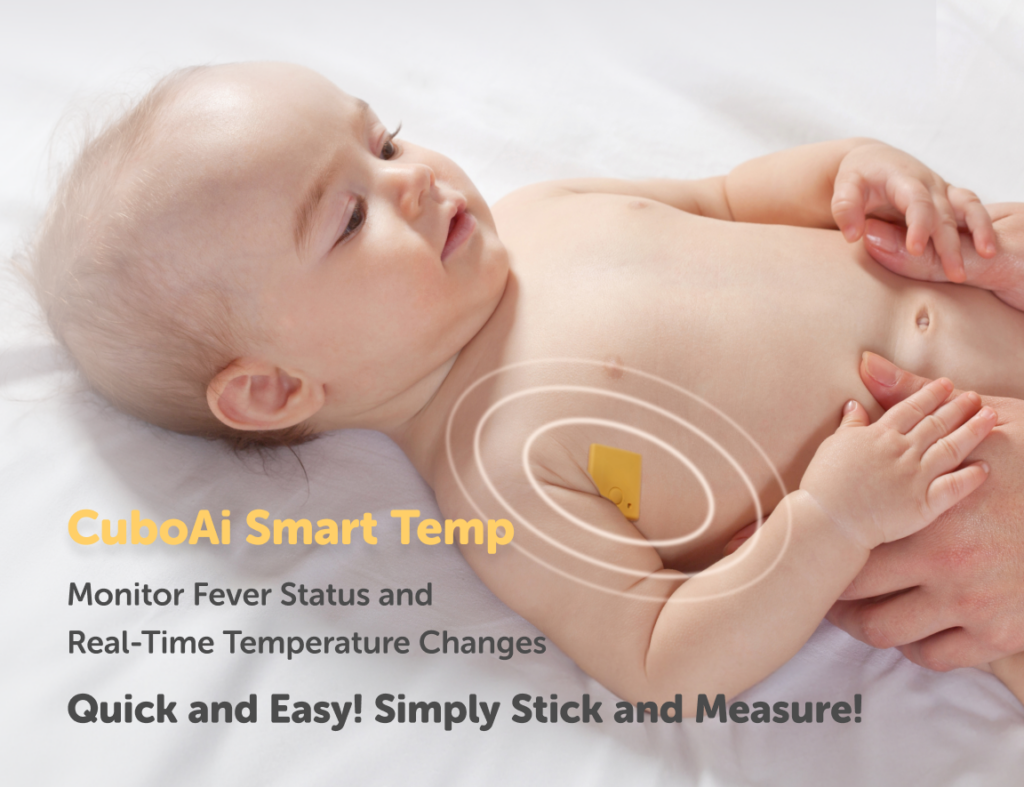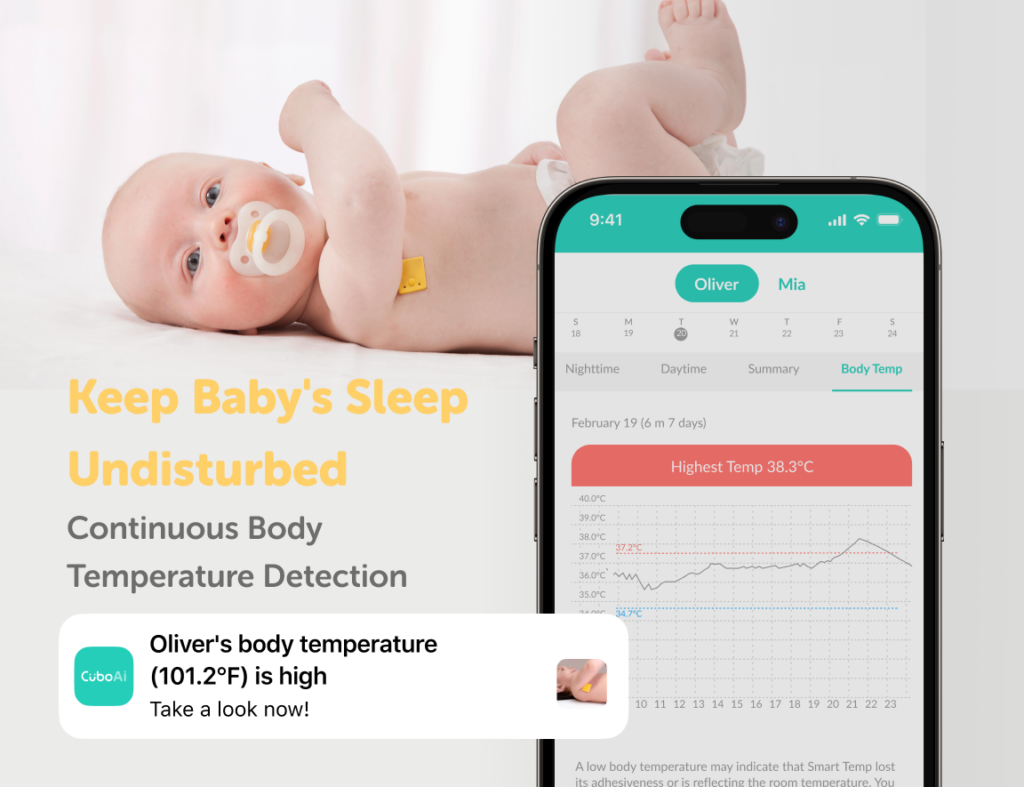What is a Fever?
A fever is when the body temperature rises above the normal range: typically defined as a rectal temperature over 38°C (100.4°F), an oral temperature above 37.8°C (100°F), or an armpit temperature exceeding 37.2°C (98.9°F). The most common cause of a fever is an infection: when viruses or bacteria invade the body, the immune system responds by raising the body temperature to help fight off the infection. During a fever, hands and feet may feel cold, and shivering may occur due to constriction of the blood vessels in the skin, which leads to heat loss. Muscles then contract to generate heat, leading to an increase in body temperature. Once the symptoms subside, the body temperature returns to normal.
Measuring a Fever
Today, mercury thermometers are no longer used, with ear thermometers being one of the most common alternatives. However, since newborns have smaller ear canals, ear thermometers may not be suitable. In these cases, digital thermometers are often used to measure rectal or armpit temperatures. Ear thermometers use infrared technology to measure the temperature of the eardrum. The thermometer is simply placed into the ear canal to take the reading. However, results may be influenced by factors such as ear canal size or earwax, which may lead to different readings in each ear.
In addition to single-use thermometers, there are more convenient and accurate options for continuous temperature monitoring, such as temperature-sensing patches. These products can track a newborn’s temperature changes continuously, making them an ideal choice for new parents. They not only eliminate the need for accuracy concerns with each measurement but also provide a more convenient way to care for the baby, especially at night. This allows parents to monitor their baby’s temperature without disturbing their sleep, ensuring peace of mind.

Fever’s Impact on Immune Function
A fever not only strengthens the immune system, but also reduces mortality rates. Animal studies have shown that during a fever, the growth of microorganisms slows down, while the movement and division of white blood cells increase. Additionally, the secretion of cytokines and antiviral activity is enhanced. A fever also serves as a warning sign of illness, causing feelings of fatigue, the urge to rest, and a reduced appetite. These symptoms prompt individuals to seek treatment and aid in speeding up the recovery process.
Fever Care and Reducing a Fever
When a child has a fever, using air conditioning or a fan is acceptable, but it’s important to maintain a comfortable indoor temperature. Aspirin should not be taken, and fever-reducing medications must be used with caution. The two most commonly used antipyretics are acetaminophen and ibuprofen, which are available in various forms, including oral syrups, tablets, and rectal suppositories. It’s crucial to avoid using multiple fever-reducing medications simultaneously, as this could cause the body temperature to drop too low and pose danger.
Additionally, it’s important to encourage the child to stay hydrated. Drinking water or consuming water-rich foods like fruits is highly recommended. The child can engage in light activities but should refrain from strenuous exercise.
Common Misconceptions About Fevers
A common misconception is that any fever will cause brain damage, but this is not true. Only temperatures exceeding 41.7°C (107°F) can impact brain function. The severity of a fever does not necessarily indicate the severity of an illness, as there are cases where serious infections result in normal or even lower body temperatures. Many parents believe that a fever always requires antibiotic treatment. However, most fevers are caused by viral infections, and antibiotics are only necessary for bacterial infections.
Fear of fever often leads to frequent temperature checks, preventing the child from getting adequate rest. This anxiety can also result in unnecessary doctor visits, excessive medical testing, overuse of fever-reducing medications, and inappropriate use of antibiotics—all of which increase the risk of side effects and medical costs.
For effective fever care, combining a temperature-sensing patch with a baby monitor is highly recommended. This setup allows parents to monitor their baby’s condition via a smartphone, receiving immediate alerts if the temperature becomes too high or too low. During long nights, this reduces the stress of frequent temperature checks, enabling the baby to rest more. It also significantly shortens parents’ response time to any potential issues, ensuring the baby receives prompt care and making fever management simpler and more reassuring.

When to Seek Medical Attention
You should visit a clinic if your child experiences any of the following fever-related symptoms:
- Body temperature over 39°C (102.2°F) for children under 2 years old
- Noticeable ear pain, abdominal pain, headaches, or painful urination
- A fever lasting more than 3 days
- No obvious symptoms
- Vomiting accompanied by diarrhea
- Fever returning after being fever-free for more than 24 hours
- A history of febrile seizures
- Parents feeling concerned or unsure about the child’s fever
Immediate emergency room attention is required if the child shows any of the following signs:
- An infant under 3 months old
- A temperature over 40.5°C (104.9°F)
- Inconsolable crying
- Low energy, excessive sleepiness, or confusion
- Seizures
- Stiff neck
- Skin showing petechiae (small red or purple spots) or bruises
- Difficulty breathing or bluish lips
- Persistent vomiting or blood in stools
What Information Should Parents Provide to the Doctor About a Fever?
When consulting a doctor about your child’s fever, be prepared to share the following details:
- When the fever started
- The highest recorded temperature
- The child’s food and fluid intake
- Activity level and overall behavior
- Skin color and breathing status
- Urine output and color
- Stool consistency and color
- The amount and color of any vomit
- Travel history, occupation, contact history, and cluster (TOCC)
Tips for Caring for a Child with a Fever
Finally, remember the correct understanding of “fever”: it is not an illness but a symptom, much like coughing or a runny nose. It typically lasts for 3 to 5 days and serves the purpose of fighting off infections by eliminating invading viruses or bacteria. When a child has a fever, observe their activity level, ensure they stay hydrated, and allow them to rest. Watch for any signs of serious illness, and seek medical attention if needed for proper evaluation and treatment.
Key tips for caring for a child with a fever:
- Encourage the child to drink plenty of water to stay hydrated.
- Allow light activity but avoid strenuous exercise.
- Keep the indoor environment cool; use air conditioning or a fan if necessary.
- You can use a lukewarm cloth to gently compress the child’s body to reduce the temperature, but avoid using ice water or rubbing alcohol.
I loved as much as youll receive carried out right here The sketch is attractive your authored material stylish nonetheless you command get bought an nervousness over that you wish be delivering the following unwell unquestionably come more formerly again as exactly the same nearly a lot often inside case you shield this hike
This is my first time pay a quick visit at here and i am really happy to read everthing at one place
Your blog post was like a breath of fresh air. Thank you for reminding me to slow down and appreciate the beauty of life.
For the reason that the admin of this site is working, no uncertainty very quickly it will be renowned, due to its quality contents.
very informative articles or reviews at this time.
Great piece! Anyone with even a passing interest in the subject should read your in-depth analysis and explanations. Your inclusion of examples and practical ideas is really appreciated. We appreciate you being so kind with your time and expertise.
Thank you for this insightful post. The way you presented the information made it easy to understand and apply. I appreciate the effort you put into researching and writing this. It’s a great resource for anyone looking to learn more about this subject.
I love how you made this topic feel approachable.
Great article! Your insights are very valuable, and the way you presented the information made it easy to understand. I appreciate the time and effort you put into researching and writing this. It’s a great resource for anyone interested in this topic.
Thanks for sharing your knowledge in such an understandable way.
I’m so glad I found this post—super helpful!
You’ve made the subject matter relatable,
Excellent piece! You really impressed me with your thorough research and insightful commentary on the subject. The way you write is captivating and the plot flows well. Your use of concrete examples greatly aided my comprehension of the ideas. I appreciate you taking the time to provide this helpful data.
This is a very well-thought-out article—kudos!
This post is full of helpful tips and insights—great work.
This is one of the best explanations I’ve seen on this subject.
I truly appreciate your technique of writing a blog. I added it to my bookmark site list and will
I appreciate you sharing this blog post. Thanks Again. Cool.
I’m often to blogging and i really appreciate your content. The article has actually peaks my interest. I’m going to bookmark your web site and maintain checking for brand spanking new information.
I really like reading through a post that can make men and women think. Also, thank you for allowing me to comment!
very informative articles or reviews at this time.